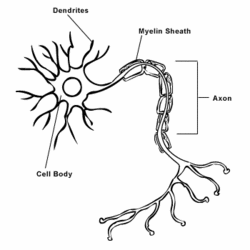Neuron: Difference between revisions
Jump to navigation
Jump to search

imported>Rahmat Muhammad mNo edit summary |
imported>Rahmat Muhammad mNo edit summary |
||
| Line 2: | Line 2: | ||
[[Image:Neuron diagram with labels.gif|right|thumb|250px|{{#ifexist:Template:Neuron diagram with labels.gif/credit|{{Neuron diagram with labels.gif/credit}}<br/>|}}Labeled diagram of a neuron.]] | [[Image:Neuron diagram with labels.gif|right|thumb|250px|{{#ifexist:Template:Neuron diagram with labels.gif/credit|{{Neuron diagram with labels.gif/credit}}<br/>|}}Labeled diagram of a neuron.]] | ||
<br/> | <br/> | ||
In [[biology]], a '''neuron''' is a [[cell]]that specializes in information transfer, and the fundamental unit of the [[nervous system]].<ref>Zigmond M, et. al., eds. (1999) ''Fundamental Neuroscience'' ISBN 0127808701</ref> Neurons can initiate and transmit the electrical signals necessary for the proper function of most biological organisms. Typically, neurons can be divided into three regions which allow them to receive and transmit signals. Neurons have a body or [[soma]] which contain the [[cell nucleus]] and other [[organelle]]s which are required for normal cell functioning. Neurons also have [[dendrites]] which allow them to receive information, and [[axons]] which allow them to transmit signals to other neurons in the organism.<ref>Purves D, et. al., eds. (1997) ''Neuroscience'' ISBN 0878937471</ref> | In [[biology]], a '''neuron''' is a [[cell]] that specializes in information transfer, and the fundamental unit of the [[nervous system]].<ref>Zigmond M, et. al., eds. (1999) ''Fundamental Neuroscience'' ISBN 0127808701</ref> Neurons can initiate and transmit the electrical signals necessary for the proper function of most biological organisms. Typically, neurons can be divided into three regions which allow them to receive and transmit signals. Neurons have a body or [[soma]] which contain the [[cell nucleus]] and other [[organelle]]s which are required for normal cell functioning. Neurons also have [[dendrites]] which allow them to receive information, and [[axons]] which allow them to transmit signals to other neurons in the organism.<ref>Purves D, et. al., eds. (1997) ''Neuroscience'' ISBN 0878937471</ref> | ||
==References== | ==References== | ||
<references/> | <references/> | ||
Revision as of 18:56, 10 January 2008
In biology, a neuron is a cell that specializes in information transfer, and the fundamental unit of the nervous system.[1] Neurons can initiate and transmit the electrical signals necessary for the proper function of most biological organisms. Typically, neurons can be divided into three regions which allow them to receive and transmit signals. Neurons have a body or soma which contain the cell nucleus and other organelles which are required for normal cell functioning. Neurons also have dendrites which allow them to receive information, and axons which allow them to transmit signals to other neurons in the organism.[2]
References
- ↑ Zigmond M, et. al., eds. (1999) Fundamental Neuroscience ISBN 0127808701
- ↑ Purves D, et. al., eds. (1997) Neuroscience ISBN 0878937471
